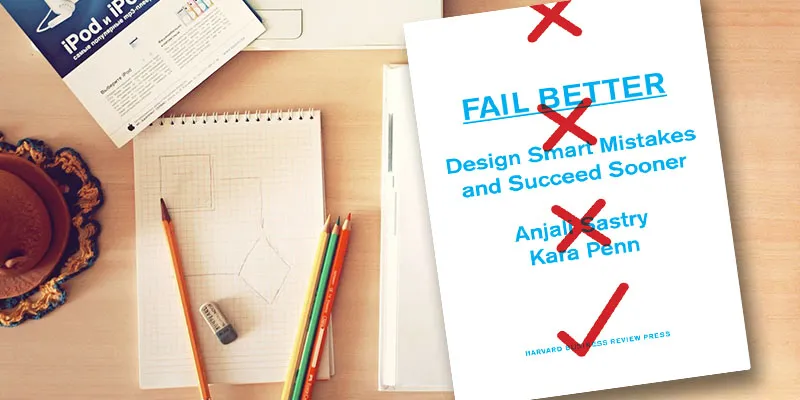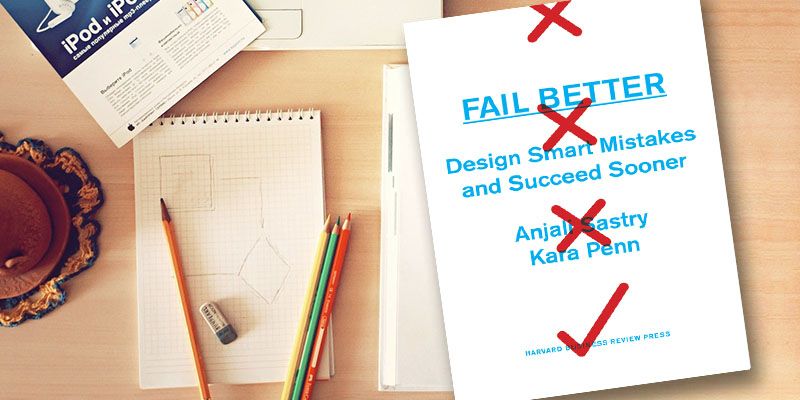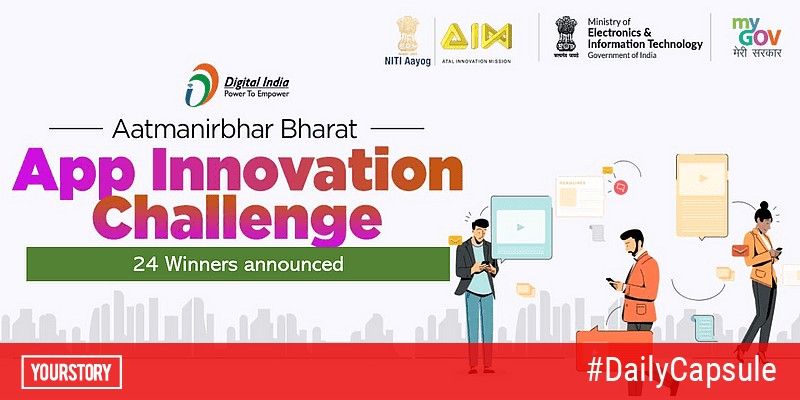Fail better to succeed sooner: 5 tips for entrepreneurs and project managers
In innovation and project management, organisations need to boldly experiment, cleverly learn from failures, and calibrate their efforts. This is much easier said than done. In practice, managers often fail, are risk-averse and do not learn from failures.

Failures need to be seen as stepping stones to success, and fail-safe approaches and stories need to be shared with a wider audience, according to Anjali Sastry (an MIT lecturer) and Kara Penn (co-founder of Mission Spark). Their book ‘Fail Better: Design Smart Mistakes and Succeed Sooner,’ provides useful insights into interpreting, planning, and learning from failures.
The book takes principles from scientific methods, lean startup management and agile software development and generalises them to a broader audience. (Also see my book review of ‘Wisdom of Failure’ by Laurence Weinzimmer and Jim McConoughey.)
Related titles include: ‘Brilliant Mistakes’ by Paul Schoemaker; ‘Failing Forward: Turning Mistakes into Stepping Stones for Success’ by John Maxwell; ‘The Up Side of Down: Why Failing Well Is the Key to Success,’ by Megan McArdle; and ‘Smartcuts: How Hackers, Innovators and Icons Accelerate Success’ by Shane Snow.
The book is comprehensive with lots of case studies, though the material could have been shortened. Here are five useful tips – my takeaways from the book.
- Understand the context and types of failures
Failures happen: get used to it and don’t set yourself up for a rude shock. “Build resilience for the ups and downs to come,” say the co-authors. They advise readers to learn to map the different types of mistakes – mistakes you can learn from, mistakes beyond your control, dumb or avoidable mistakes, and wasted mistakes (with no learning captured). Learning better from failures should eventually help you succeed more often.
“With the right methods applied to their design, execution and analysis, even the most unglamorous activities can yield new insights and fuel innovation,” say Sastry and Penn. It is important to enable smart mistakes and avoid uninstructive ones. “The right kind of failure – small-scale, reversible, informative, linked to broader goals, and designed to illuminate key issues – paves the way to success,” the co-authors add.
Failures can happen due to limitations of cognitive reasoning, emotional shortcomings, process blocks, project assumptions, planning deficiencies, organisational inertia and cultural aversion. In an increasingly inter-connected, noisy, digital and unpredictable world, learning quickly and smartly from mistakes - large and small - will be the key to long term success.
Projects are vehicles for innovation, and failures in the project journey lead to discovery and learning, and the unearthing of inherent flaws and untested assumptions. Hurdles could morph into springboards for recalibration, provided the right approaches to problem framing and compassionate learning are inculcated.
“When failure is inevitable in the innovation economy, weeding out useless failures is an efficient way to succeed,” says Desh Deshpande, Trustee, Deshpande Foundation. This idea is iterated by Una S. Ryan, Chair, Bay Area BioEconomy Initiative: “There are some clear choices in life: fail to learn or learn to fail.”
- Draw inspiration from stories of instructive failures
The book covers a wide range of organisations and movements where learning from failure was embedded and shared: WiPower, Pivots Software, Eli Lilly, IDEO, and even the US Civil Rights Movement. Other well-documented stories of “success extracted from the jaws of failure” include Post-It Notes, Viagra, New Coke and the renewal of Apple.
Founder Ryan Tseng of wireless charging startup WiPower, in the initial growth stage, identified an early failure in the lack of communication and stakeholder alignment. Tseng did not stumble but learned the lessons, and eventually sold the company to Qualcomm in 2010.
Travel website Kayak.com uses A/B testing or split testing as a way of life to develop new online features. Ad-tech startup LaunchBit used rapid prototyping and testing of its proposed email ad solution to discover new opportunities and eventually pivot to channels beyond email.
Successful venture investor Eric Hjerpe documents his investment decisions, revisits his notes in the light of new developments, and makes new rules of thumb for future testing. Hjerpe shares his learnings when he mentors entrepreneurs.
Toyota uses the oobeya method, or a big room where teams share artefacts from the project journey and align their workflow accordingly. In addition to digital communication, Harley-Davidson uses sticky notes in their project room to track potential, real and unfinished issues. Hermann Miller Healthcare used a compass approach to conduct hundreds of interviews to better understand the assumptions of hospital room design, emerging technologies and family expectations.
IDEO conducts ‘bodystorming’ to immerse in and understand real-life scenarios of product usage. Eli Lilly brought in experts to gather new insights from drug development data and validate a chemotherapy drug Almita. Military and disaster management organisations use AAR (after action review) to assess operations on a regular basis.
Engineers Without Borders (EWB) published its first annual ‘failure report’ in 2008 to systematise learnings from failure. This has come to be seen as a key step in professional development and project execution at EWB.
Bangladeshi NGO BRAC, founded by Fazle Hasan Abed, uses thorough documentation, testing, research methodology and knowledge sharing in the treatment of cholera and diarrhoea. They depend on data-driven action-loop solutions in their efforts to alleviate urban poverty.
The US Civil Rights Movement used reflective practices along with iterative action to better design non-violent confrontation techniques, and learn from what worked and what failed on the frontlines in different constituencies.
- Launch every innovation project with the right groundwork
Clearly define your project’s scope for innovation, experimentation, failure and delivery. Map the actions to outcomes, and gather the required resources and team players. Have a common understanding of the goals and methods, and map out the skills and capabilities available along with collaborative activities. Plans may change, but the process of clear planning with appropriate project management tools helps identify potential hurdles.
Craft a concise, specific and measurable problem statement. “Keep it simple, supple and scrappy,” the co-authors advise. Clearly identify the target audience and build a story or comic-book style narrative flow around the project or innovation. Drawing out a project impact map with deliverables, influencing factors, assumptions and desired outcomes also helps.
- Build and refine ideas and products through iterative action
“Think of your project as a cauldron for experimentation and learning,” say the co-authors. Gather adequate data and interpret them in chunks at regular interviews. Develop an agile and responsive method of action; design activities specifically with testing, learning and corrective actions in mind. “Build a team habit of disciplined decision-making. Track every surprise you encounter,” they add.
Teams should neither be stuck in analysis paralysis nor rush headlong towards deliverables. Action and thought in work design should be interleaved in a plan-test-reflect-decide cycle. Predictions should be documented and tests sequenced in a manner appropriate for combining lessons. Visual prototyping and computer simulations are useful options. Internal or external experts can be brought in to support mental models and domain maps or suggest alternatives.
- Identify and embed the learning
Share the lessons in a way that instructive insights can be drawn within the team, across the organisation and beyond to the wider society. This can be done by gathering project archives, taxonomising them, and reflecting on the surprises and deviations in the project timeline. The learnings should impact project practices, management techniques and team skills.
“Knowledge management is most effective when it involves multiple channels,” the co-authors advise. This knowledge can be shared through internal newsletters, memos, staff meetings, external blogs, white papers and conference sessions.
In sum, key success factors for failing better are build-for-learning design, collaborative inquiry, realistic optimism and an expansive growth-oriented mindset. The methods in the book for learning from instructive mistakes and avoiding unproductive missteps can be used to learn from past projects or be embedded in current and future projects.
The book also points the way towards further research on cultural attitudes towards failures in countries around the world, comparisons between different sectors, and tips and tools for mindful learning methods and scenario envisioning in personal life.
“Cultivate the skills of looking at the big picture,” the co-authors advise. Preventable, wasteful and uninstructive failures should be avoided. The only benefit of failing is the learning derived from it. Learning on the job should be an additional skill for which managers should be assessed.
“Our mission is make the world better, one project at a time,” conclude Sastry and Penn.
Author profiles:
Anjali Sastry is senior lecturer at MIT Sloan School of Management and lecturer in the Department of Global Health and Social Medicine at Harvard Medical School. Her research investigates global health delivery and management, applying systems thinking and practical, business-based approaches in low-resource settings. She has conducted numerous field studies and collaborative action projects in Africa and Asia and advises and teaches internationally.
Kara Penn is cofounder and principal consultant at Mission Spark, where she works on the front lines of practical management to implement new approaches in complex settings. She has guided more than sixty NGOs, social enterprises, corporations, and foundations. She has been recognised by fellowship programs including Coro, Watson, and Forté.











